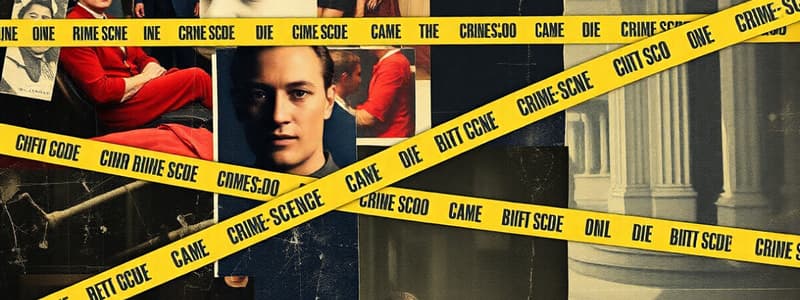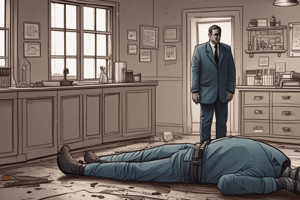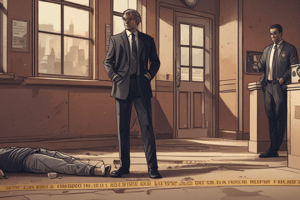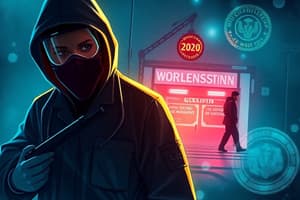Podcast
Questions and Answers
What is the primary criterion for physical evidence to aid investigators effectively?
What is the primary criterion for physical evidence to aid investigators effectively?
- Its recognized presence at the crime scene. (correct)
- Its market value.
- Its volume and mass.
- Its age and origin.
How does a thorough investigation conducted by police officers impact the workload and subsequent analysis performed in a crime laboratory?
How does a thorough investigation conducted by police officers impact the workload and subsequent analysis performed in a crime laboratory?
- It enhances the chances for a successful resolution, in conjunction with forensic testing. (correct)
- It reduces the need for forensic testing.
- It makes the crime laboratory obsolete.
- It overwhelms the laboratory with useless information.
What is the main responsibility of the first officer who arrives at a crime scene?
What is the main responsibility of the first officer who arrives at a crime scene?
- To immediately collect evidence.
- To release information to the press.
- To preserve and protect the area. (correct)
- To begin interrogating witnesses.
Why is it important to log who enters and exits a crime scene?
Why is it important to log who enters and exits a crime scene?
What should the lead investigator do after securing the crime scene?
What should the lead investigator do after securing the crime scene?
How are digital photographs valuable at crime scenes?
How are digital photographs valuable at crime scenes?
What is the most important action to perform before photographing objects at a crime scene?
What is the most important action to perform before photographing objects at a crime scene?
What would be the correct sequence of photos for documenting evidence at a crime scene?
What would be the correct sequence of photos for documenting evidence at a crime scene?
Why is it important to stitch together individual images electronically to create a 3-D panoramic view of a crime scene?
Why is it important to stitch together individual images electronically to create a 3-D panoramic view of a crime scene?
What is a disadvantage of using video recordings at crime scenes?
What is a disadvantage of using video recordings at crime scenes?
What type of information should be included in a rough sketch of a crime scene?
What type of information should be included in a rough sketch of a crime scene?
What is the simplest way to designate an item in a sketch?
What is the simplest way to designate an item in a sketch?
What is the purpose of CAD (computer-aided drafting) in crime scene investigation?
What is the purpose of CAD (computer-aided drafting) in crime scene investigation?
How should the search for physical evidence at a crime scene be conducted?
How should the search for physical evidence at a crime scene be conducted?
What is the purpose of 'strip or line search pattern'?
What is the purpose of 'strip or line search pattern'?
Which area should vacuum sweepings NOT come from?
Which area should vacuum sweepings NOT come from?
For what reason should ordinary mailing envelopes not be used as evidence containers?
For what reason should ordinary mailing envelopes not be used as evidence containers?
Why is it important to package each item of evidence separately?
Why is it important to package each item of evidence separately?
What is the benefit of using paper bags for packaging biological materials?
What is the benefit of using paper bags for packaging biological materials?
Why is maintaining the chain of custody important?
Why is maintaining the chain of custody important?
What information should a chain-of-custody record include at a minimum?
What information should a chain-of-custody record include at a minimum?
When is needed standard/reference samples?
When is needed standard/reference samples?
What can the investigator do to ensure biological specimens are safe?
What can the investigator do to ensure biological specimens are safe?
What is the message given by The Supreme Court regarding when to investigate and retrieve evidence at a crime scene?
What is the message given by The Supreme Court regarding when to investigate and retrieve evidence at a crime scene?
Flashcards
Physical Evidence
Physical Evidence
Any object that can establish that a crime has or has not been committed or can link a crime and its victim or its perpetrator.
Chain of Custody
Chain of Custody
A list of all people who came into possession of an item of evidence.
Standard/Reference Sample
Standard/Reference Sample
Physical evidence whose origin is known, such as fibers or hair from a suspect, that can be compared to crime-scene evidence.
Buccal Swab
Buccal Swab
Signup and view all the flashcards
Substrate Control
Substrate Control
Signup and view all the flashcards
Rough Sketch
Rough Sketch
Signup and view all the flashcards
Finished Sketch
Finished Sketch
Signup and view all the flashcards
Study Notes
The Crime Scene
- Chapter Two discusses the "crime scene", and all important aspects of ensuring the crime scene is preserved and processed correctly.
Key Terms
- Several key terms have been determined to be important for understanding:
- Buccal Swab
- Chain of Custody
- Finished Sketch
- Physical Evidence
- Rough Sketch
- Standard/Reference Sample
- Substrate Control
Amanda Knox Case
- Amanda Knox, an American student, was involved in a controversial murder case in Italy.
- In September 2007, Knox moved to Perugia, Italy, as a foreign exchange student
- Knox shared an apartment with Meredith Kercher and two other women
- She became romantically involved with Raffaele Sollecito, who she'd often spend the night with
- On November 1, Kercher was found murdered in her bedroom, covered in blood and with stab wounds
- Knox and Sollecito were charged with murder and sexual assault, creating an international media storm
- Knox was convicted of slander, sexual violence, and murder and sentenced to 26 years in prison
- Her conviction was overturned four years later by the Italian Supreme Court, and a new trial was ordered
- The case against Knox in the original trial hinged on a bra clasp and a kitchen knife
- The kitchen knife - found in Sollecito's kitchen, had Kercher's DNA on the blade and Knox's DNA on the handle
- The bra - allegedly belonging to Kercher, was reported to have Knox's DNA on the clasp
- Defense experts questioned the DNA lab's procedures and crime scene management during the appeal process after evidence review
- It was found by authorities that Italian authorities failed to properly control, document, and preserve evidence at the scene
- For instance, the bra wasn't even taken during the initial crime scene search, but 40 days later
- The Supreme Court of Cassation in Italy cleared Knox and Sollecito in 2015, citing potential evidence contamination
- After assessing the evidence, the court saw "stunning flaws in the investigation and increased media attention"
- There were no "biological traces" linking Knox and Sollecito to the killing
- Rudy Guede, a third suspect who had fingerprints in Kercher's bedroom and DNA on and inside Kercher's body, was found guilty of murder and is still serving time
Physical Evidence
- Crime laboratories rely on physical evidence
- Physical evidence includes any objects that prove whether a crime has occurred or connect a suspect/victim to a crime
- Physical evidence's presence needs to be identified quickly to aid the investigator efficiently
- The scientist would be overburdened if every natural and commercial object in a crime's proximity were gathered
- Physical evidence is most valuable in criminal investigations when gathered with a collector's in-depth knowledge of the crime laboratory
- Forthcoming chapters will discuss ways for scientists to assess physical evidence
- Technology has increased the capabilities of crime laboratories, but investigators should not be complacent due to these developments
- Crime labs alone do not solve crimes
- Thorough investigations conducted by professional police officers lead to more solved cases
- Though forensic science is important, it is only one piece of an investigation
- Investigators must recognize physical evidence and properly preserve it for lab examination
Securing and Isolating the Crime Scene
- The first officer at a crime scene preserves and protects the area
- Officers should rely on their training to handle any dangerous situations
- Note any vehicles or people leaving the crime scene
- First priority goes to medical assistance and arresting the perpetrator
- Unauthorized people must be excluded from the scene ASAP
- Medical workers should approach a body indirectly, to avoid disturbing evidence
- The first responding officer evaluates the victim and records any statements
- Figure 2-1 shows the isolation of the area in practice with measures to close off the scene.
- The boundaries should include the crime's center, entry/exit routes, and areas where evidence may be discarded
- Ropes, barricades, and guards prevent unauthorized access
- Suspects, witnesses, and other individuals on scene must be identified and detained
- Exclude unauthorized personnel, including friends/family of the victim
- Only assigned investigative personnel should be admitted
- A log of who enters/exits and when must be kept by responding officers
- Excluding unauthorized staff may be difficult
- Violent crimes draw more attention from curious individuals
- Every entrant is a possible destroyer of physical evidence
- An officer in charge of protecting the crime scene requires the power to exclude all officers not directly involved in the investigation
- Always remember crime scenarios where the horde trampled on physical evidence
- A well-trained crime-scene investigative team must isolate the crime scene
- After securing the location, a lead investigator will assess the scene; determine scene perimeters
- The investigator logically deduces the clear items of crime-scene evidence
- Document and photograph obvious evidence, then take a walk-through to develop a method to examine/document the scene
- Ferguson, Baltimore, Cleveland, and Staten Island racial unrest has increased body-worn camera issues
- A tiny clip-on camera seems like an easy method to secure crime scene efforts; although implementation has many concerns to iron out
- Law enforcement has not universally accepted body-worn cameras or implemented management protocols for them
- One main concern for body-worn cameras is secure data storage and data management, but the devices do not replace digital/video cameras
Altering the Scene
- Personnel are not to do anything in the scene which alters it
- Aspects of the scene should not be disturbed unless they pose an urgent threat
- There should be no opening or closing of faucets or flushing toilets at scenes
- Officers should not adjust windows, doors, or the heating/air conditioning, as this can alter temperature conditions
Recording the Crime Scene
- Investigators have limited time at an untouched crime scene
- Crime scene opportunities should not be lost.
- Records are useful for investigations, but mandatory at trial to show the condition of the crime site and evidence location
- Crime scene recording is achieved via notes, photography, and sketches
- All three should ideally be employed, but financial/personnel limitations can restrict the use of photography in some cases
- Sketches and notes should always be taken, however
- Notes should begin with the call to scene investigation, and include the caller details, time of contact, and disclosure, alongside the case number
- The lead investigator records arrival date/time, those who are present, and the names of any other personnel contacted
- Keep a record of personnel leaving and entering the scene
- Record tasks assigned to team members, starting and ending times
- Investigators take initial walk-through prior to sketching, photograhing, and searching for evidence
- During the walk-through, record notes on aspects of the crime scene in its original untouched condition
- The notes should be uniform, written in ink, and kept in a bound notebook
- Ensure that notes are not based on memory, but are contemporary written at the same time as the crime scene investigation
- After the evidence search, team members mark the location of all evidence and describe it in their notes
- In homicides, the investigator should observe and record the state of body before medical examiner or coroner handles it
- Record suspects or victims
- Audio notes are kept by digital voice recorders, and then copied physically to a disk
- Narrating a video of the crime scene to combine these methods of documentation is an option
- Crime scene checklists should be filled out during the documentation to ensure all jobs are completed
Photography
- Photographing a crime scene has one main rule - it must be unaltered
- Position of evidence should be taken using overviews and close-ups
- The objects themselves should be taken in close-up
- A ruler or scale should be present to indicate signficance
- Four photographs are needed at minimum: overview shot, medium range shot, close-up photograph, and clsoe-up with scale
- This photographic series creates a good visual record of the position of all evidnece
- New cameras which take dozens of photographs by scanning can create a 3D model of the scene
- Cameras capable of producing 3D scan locations from multiple data are used
- Video is used and can be done by digital means, too
- All relevant areas should be taken using digital video, as well as close-ups
- An investigator narrates with one doing the shooting
Body Worn Cameras
- Police and the community have seen a relationship disruption over excessive force and failure to collect evidence
- Many cases are brought by witnesses
- Body Worn Cameras (BWCs) offer a potential method for police to record and document their actions
- President Obama pushed for federal involvement for training for BWCs in support
- Technology should result in legitimacy and accountability in this regard per these BWCs; these cameras record audio and video footage and allow for computer use, recording with a single button
- BWCs offer efficient tool for collecting evidence; offer medical help. BWCs can also record the officer performing various tasks
- The scenes are often difficult and locations often contain hundreds of evidence
- BWC should help in these efforts
Sketches
- Sketches in crime scenes serve many purposes pertaining to the legal investigation
- The sketch helps to show the indoor or outdoor crime scheme and offers a view of features related to investigation
- Possible pathways through crime scene should show with sketch
- Making exact sketch when lacking time is often a problem; rough sketch is okay
- Accurate dimensions are important
- The use of sketching kit helps
Finished Sketch
- Accurate sketch must involve care and concern, reflecting all the rough measurements
- Computer software helps in making diagrams
- These can involve intricate details such as blood spatter
Systematic Search for Evidence
- In reconstructing any crime, the investigator needs to look over evidence and oversee anything
- Some agencies have field evidence to search; they have equipment and skill to examine crime
- How one conducts such a search will deal with the location
- One needs to oversee the collection in case of need for duplication of effort
Search Patterns
- One or two investigators should utilize strip or line search pattern and move from one side to another
- This works best when perimeters are known
- The boundaries must be well established in order for method to be effective
- The grid search is very thorough and employs tow people performing lines through all axis corners
- This can only work when the corners are well established
- Spiral pattern involved investigator inward/outward
- Wheel or ray search pattern involves a set of groups searching rays to their centers. This is not preferred as it leaves areas between "rays" unsearched.
- Quarant or Zone methods breaks a scene into zones; each team will be assigned. This search type suits larger areas.
Locating Physical Evidence
- Search may center on the weapon and assailant - linking suspects to crime scene to help make case
- Vehicle search is detailed; the car has an under carriage that is important to scrutinize
Collecting and Packaging Physical Evidence
- Physical evidence ranges from smaller traces of crime and can be discovered in lab later on
- Collect things like hair to help the processes
- Clothing item should be carefully handled and wrapped separately
- Vacuums with filters to find evidence are good tools
- Scraping under the victim's nails with toothpick can be used for micro exam
- Physical evidence must extend beyond crime scene to autopsy
- Medical examiner carefully examines victim to determine death cause
- Tissues are then retained
- Evidence technicians handle mobile crime laboratories
- These can carry necessary items for protection, photos, collections, and fingerprint processing
Handling Evidence
- Investigators must manage to process the evidence in a way that doesn't alter anything from its time on scene to time in laboratory
- Disposable protection like gloves should be used
- Clean and sanitize equipment between uses
- Don't move or document anything until documentation on appearance is found
- A good idea is to submit entire item to laboratory
- Forceps can also be used
- Remove specimens appropriate; a blood stain may need to scrape the surface
- Well-prepared collectors are a boon
Packaging Evidence
- A variety of tools are often with a collector
- All different items go to collection separately; avoid damage
- For anything biological, use disposable tools; accumulation can lower value; paper packaging is easy to write on but can be sturdier per the item.
- Use a red biohazard sticker which ensures handlers recognize the blood samples, etc
DNA Evidence
- DNA can be used to help make the subject easier; the technique is helpful for this task
- Search anything touching victim
- Bed sheets with cells to find the issue
Best Practicce for Biological Evidence Packing
- Use bags, papers, cardboard, etc
- All are helpful for wrapping
- Evidence is sealed to prevent the transfer and contamination
- Seal in a way that causes alteration if it is tampered with
- Each item must be packaged separately
- Biohazzard labels must be present
- Plastic bags are not preferred; if wet, use an impermeable setup
- Seal packages and add label
Contamination
- Contamination is number-one concern for collecting DNA (via coughs, sneezees, etc)
- Always use face mask during collection for instance
- Coveralls also recommended
Chain of Custody
- Continuity of possession must make the trial
- Standard procedure is a guarantee of the evidence
- Those who handled the device must be accounted for; failure is a major mistake!
- Carefully package all items
- Label collector initials, as well as the date, on the article iteself
- Record things in appropriate forms
- It's helpful to obtain Standard/Reference Samples for items including glass, hair, and blood
Standard/Reference Samples
- Investigation may include paint from suspect vehicle
- It's important to make samples from these actions
Substrate Controls
- Substrate Controls have items that are materials from close distance
- Investigators ensure a surface has had gasoline exposure
- Thorough collection measures are good
- Evidence is given to a laboratory or to the mail
- Care is necessary to ensure it's not in transit to the laboratory
Crime Scene Safety
- AIDS increased due to crime; body fluids have affected this; precautions must be used
- Gloves and masks must be used in these cases
Studying That Suits You
Use AI to generate personalized quizzes and flashcards to suit your learning preferences.




